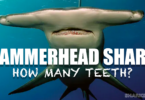Sharks are the most fascinating creatures in oceans and are the balancing component of the environment. They have been around the earth for over 400 million years and belong to the family Chondrichthyes, which evolved around 500 million years ago. Sharks are known as the most powerful and apex predators of the ocean. They have fins on their bodies and breathe through gills like other aquatic vertebrates such as fish. However, the most distinctive feature between sharks and fish is their skeleton.

The shark species have different body structures compared to the other marine animals. The major query about sharks is: Do sharks have bones? No, the sharks have no bones, their bodies are made up of cartilage, the same soft material as the nose of a human and the tip of their ear is made up of. All sharks are made up of the same material from dwarf lantern shark to the giant Whale Shark.
We will discuss the following details in the next section of this guide:
- Do Sharks Have Bones?
- Are Shark Teeth Bones?
- Are Sharks’ Jaws Made up of Bones?
- Do Sharks Have Canine Teeth?
- How Does The Cartilaginous Structure Help the Sharks in Hunting
Do Sharks Have Bones?
No, there is not a single bone in the body of the most fantastic oceanic dwellers, sharks. They are elasmobranchs, which means they have cartilaginous structures. The Ray, Sawfish, and Skates are the fellow Elasmobranchs of sharks. The skull, jaws, and spinal column of sharks are made up of cartilage. coated with a hard layer of calcium phosphate. It consists of hundreds of little, tiny calcites that are held together by collagen fibers.
The cartilaginous structure of sharks is better for their lifestyle as it is lighter than bones and helps them to swim faster than the other fish species like bony fish. The only part of sharks which is not made up of cartilage is their teeth.

Are Shark Teeth Bones?
No, the teeth of the sharks are not bones. Each shark species has a unique shape of teeth depending on their lifestyle and diet. However, the teeth of all sharks are made up of dentin, a calcified tissue, and covered with a hard and mineral-rich material known as enamel (fluorinated calcium phosphate). The dentin has two different types depending on the structure: orthodentine, and osteodentine.
1: Orthodentine: The orthodentine has a compact and similar appearance just like the dentin of human teeth. The Tiger Sharks have orthodentine surrounding the pulpy cavity.
2: Osteodentine: The osteodentine has a spongy appearance and resembles real bone. The teeth of the Great White Shark are composed of osteodentin.

Sharks have an endless supply of teeth throughout their life. The teeth of sharks are one of the most fascinating aspects of these species. They have several rows of teeth constantly growing and shedding throughout their lives. They shed approximately one tooth per week and each shark has 35000 teeth in their entire life.
Are Sharks’ Jaws Made up of Bones?
The jaws of sharks are made up of calcified cartilage, which is less dense and more flexible than the bones as it is made up of calcium phosphate and collagen among other proteins. The calcium salt from the food they eat deposits in the cartilage of the jaws and makes their jaws strong and hard. The same material allows the jaws of sharks to fossilize quite nicely making them common fossils.

The sharks have two jaws, one is the upper jaw and the second is the lower jaw. The upper jaw is attached to the skull through the muscle ligament and connective tissues. The jaw is not rigidly attached to the skull allowing the sharks to move it on the sides and sometimes upward to eat the prey. The pressure exerted by each jaw has been measured at around 42,000 PSI. Lined with multiple rows of teeth, the jaws of sharks are best for catching, biting, and chomping their prey.
Do Sharks Have Canine Teeth?
Canine teeth are the companions of the carnivore species helping them in performing the function of ripping and eating the food. Despite being one of the largest carnivore species, sharks do not have canine teeth. They have needle-like teeth, and the shape of teeth varies from species to species depending on the habitat and diet of the species. You can easily distinguish the teeth of sharks from their unique appearance. Following are the four different types of teeth of sharks with example species:
- Dense-flattened: Angel Shark and Nurse Shark
- Needle-like: Bull Shark and Blue Shark
- Pointed lower teeth with triangular upper teeth: Great White Shark
- Non-functional teeth: Whale Shark and Basking Shark
Read this guide to get the details of four different types of teeth of shark species.
How Does the Cartilaginous Structure Help the Sharks in Hunting?
The cartilage is half as dense as bones and the following are the advantages of the cartilaginous structure of sharks:
1: The cartilaginous structure of sharks helps them swim faster than other aquatic animals.
2: The cartilage is more buoyant than the bones so allows the sharks to float without using much energy. The swim bladders of fish stop them from sinking in the water. However, the sharks do not have swim bladders so the less dense cartilage structure helps them to remain buoyant.
3: The most flexible structure of the sharks helps them give a strong bite. The upper jaw of the sharks is not attached to the skull and they have the full range of flexibility to open their mouth wide, making the downward bite more powerful and harder. This structure of jaws helps the sharks to swallow their large prey such as Sea lions.
4: The cartilaginous structure is more flexible allowing the sharks to bend and twist at greater degrees.
5: The cartilage heals quickly compared to bones allowing the sharks to heal from the injuries more quickly and easily.
FAQs
1: Can sharks get cavities?
No, the sharks never get cavities because the surface of the teeth of the shark is made up of fluoride. The outer layer of teeth is 100% fluoride making shark decay impossible.
2: What features of shark skeletons make them different from other fish?
The skeleton of fish is made up of bones, while the skeleton of sharks is made up of cartilage.
3: How many teeth does each shark have?
The number of teeth varies from species to species, on average, sharks can have between 50 and 300 teeth. Most sharks have 5 to 15 rows of teeth.
4: What are three interesting facts about shark teeth?
The interesting facts about the teeth of sharks are:
1: The teeth of sharks do not have roots; they are not attached to gums like human teeth.
2: The sharks lose at least one tooth per week.
3: The teeth of sharks can be replaced within a day of losing their teeth.
Final Thoughts
One of the unusual facts about the shark species is that they do not have a single bone in their bodies, the skeleton of sharks is made up of cartilage. However, the teeth of sharks are made up of dentin covered with the hard and strong material enamel. Each shark has a different shape and type of teeth arranged in rows. These powerful and sharp teeth allow the sharks to catch and cut their prey into pieces with ease.
The teeth of sharks are more likely to be preserved in the fossil record compared to the other parts of the body of sharks because the skeleton of sharks is made up of cartilage. The cartilage is soft flexible tissue but not as strong as bone. So, they are more prone to decomposition and deterioration after death which makes it difficult to find complete skeletons of sharks in the fossil record.







